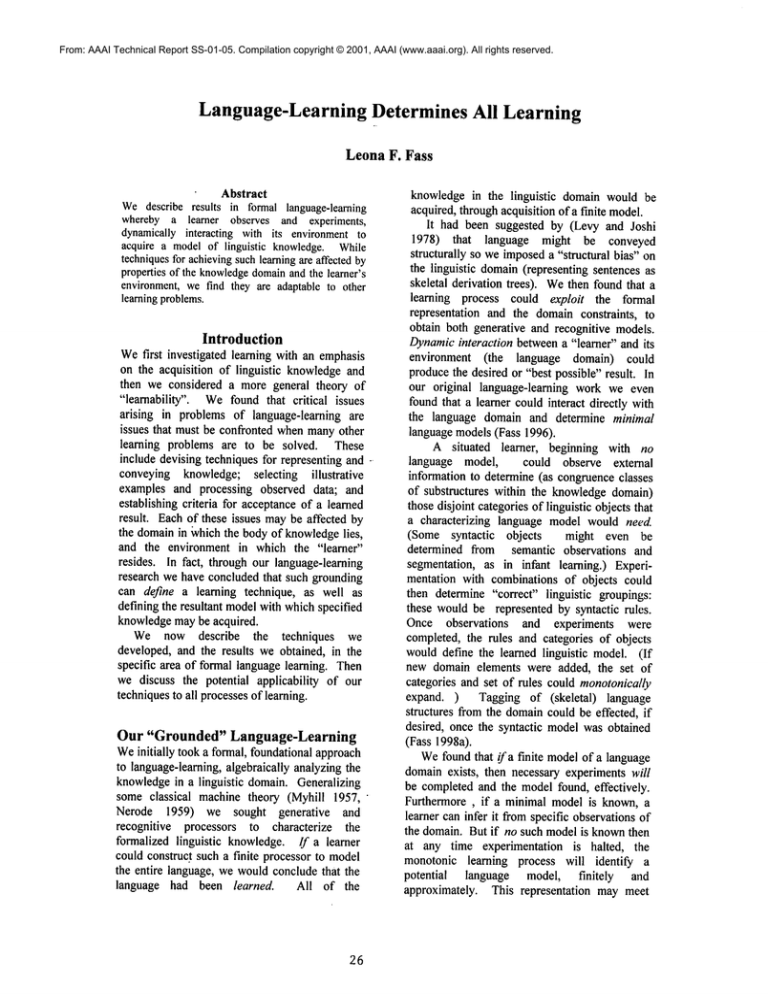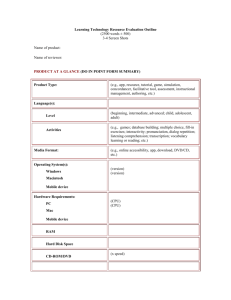
From: AAAI Technical Report SS-01-05. Compilation copyright © 2001, AAAI (www.aaai.org). All rights reserved.
Language-Learning Determines All Learning
LeonaF. Fass
Abstract
Wedescribe results in formal language-learning
whereby a learner observes and experiments,
dynamically interacting with its environment to
acquire a modelof linguistic knowledge. While
techniquesfor achievingsuchlearningare affectedby
properties of the knowledge
domainand the learner’s
environment,we find they are adaptable to other
learningproblems.
Introduction
Wefirst investigated learning with an emphasis
on the acquisition of linguistic knowledgeand
then we considered a more general theory of
"learnability". Wefound that critical issues
arising in problems of language-learning are
issues that must be confronted when manyother
learning problems are to be solved. These
include devising techniques for representing and
conveying knowledge; selecting illustrative
examples and processing observed data; and
establishing criteria for acceptance of a learned
result. Each of these issues maybe affected by
the domainin ~vhich the bodyof knowledgelies,
and the environment in which the "learner"
resides. In fact, through our language-learning
research we have concluded that such grounding
can define a learning technique, as well as
defining the resultant modelwith whichspecified
knowledgemay be acquired.
We now describe
the techniques
we
developed, and the results we obtained, in the
specific area of formal language learning. Then
we discuss the potential applicability of our
techniquesto all processesof learning.
Our "Grounded" Language-Learning
Weinitially took a formal, foundational approach
to language-learning, algebraically analyzing the
knowledgein a linguistic domain. Generalizing
some classical machine theory (Myhill 1957,
Nerode 1959) we sought generative
and
recognitive processors to characterize the
formalized linguistic knowledge. If a learner
could construct such a finite processor to model
the entire language, we wouldconclude that the
language had been learned. All of the
26
knowledge in the linguistic domain would be
acquired, throughacquisition of a finite model.
It had been suggested by (Levy and Joshi
1978) that language might be conveyed
structurally so we imposeda "structural bias" on
the linguistic domain(representing sentences as
skeletal derivation trees). Wethen found that
learning process could exploit the formal
representation and the domain constraints, to
obtain both generative and recognitive models.
Dynamicinteraction between a "learner" and its
environment (the language domain) could
producethe desired or "best possible" result. In
our original language-learning work we even
found that a learner could interact directly with
the language domain and determine minimal
language models(Fass 1996).
A situated learner, beginning with no
language model,
could observe external
information to determine (as congruenceclasses
of substructures within the knowledgedomain)
those disjoint categories of linguistic objects that
a characterizing language model would need.
(Some syntactic
objects
might even be
determined from semantic observations and
segmentation, as in infant learning.) Experimentation with combinations of objects could
then determine "correct" linguistic groupings:
these wouldbe represented by syntactic rules.
Once observations
and experiments were
completed, the rules and categories of objects
would define the learned linguistic model. (If
new domain elements were added, the set of
categories and set of rules could monotonically
expand. ) Tagging of (skeletal)
language
structures from the domaincould be effected, if
desired, once the syntactic model was obtained
(Fass 1998a).
Wefound that/fa finite modelof a language
domainexists, then necessary experiments will
be completed and the modelfound, effectively.
Furthermore , if a minimal model is known, a
learner can infer it from specific observations of
the domain. But if no such model is knownthen
at any time experimentation is halted, the
monotonic learning process will identify a
potential
language model, finitely
and
approximately. This representation may meet
established learning criteria and be accepted as
"best possible" or "goodenough".
Conclusions
and Adaptations
and Discourse Processing", invited for participation in AAAI Spring Symposium on Applying
Machine Learning to Discourse Processing,
(3pages), Stanford, 1998.
to Other
Learning Problems
Wecould obtain these satisfying results in the
language-learning case only because of the
relationship established between the learner’s
linguistic environment and the language’s
learnable model.
(Categories of domain
elements corresponded to components of the
model. Representatives of these categories
provided sufficient selected information from
which the model may be inferred.)
This
relationship existed only because we imposed
domain constraints and a structural bias that
could force the discovery of a finite learnable
result. By imposing domainstructure, we found
we had imposed
finite
realizability,
representation and leamability.
Althoughwe developed a learning process for
the linguistic
domain, precisely the same
procedures can apply in any other environment
where structure and finite representation might
exist or be imposed (Fass 1998b). Learning
wouldstill be effected by discovering disjoint
knowledgecategories (again, congruenceclasses
of structures) and constructive rules. A situated
learner, interacting with the knowledgedomain
by experimenting with representatives of these
categories, might construct a finite, minimalor
"best possible" result. Whilediscretely realizing
domain knowledge, the process developed for
language-learningthus determinesall learning.
Fass, L.F., 1998b. "Learning (Language)within
Context", Proc. of the Fourth Joint Conf on
Information Sciences / Third Internatl Conf on
Computational Intelligence and Neuroscience,
Research Triangle Park, NC, October 1998, Vol
II, 56- 59.
Gold, E.M., 1967. "Language Identification in
the Limit", Inf. Contr., Vol 10 (1967), 447-474.
Levy, L.S. and A.K. Joshi, 1978. "Skeletal
Structural Descriptions", Inf. Contr., Vol 39
(1978) 192-211.
Myhill, J., 1957. "Finite Automata and the
Representation of Events", WADC
Tech Rept,
57-624, Wright-Patterson AFB,1957.
Nerode, A., 1959.
"Linear Automaton
Transformations", Proc. AMS,IX (1959), 541
544.
Valiant, L., 1984. "A Theoryof the Learnable",
CACM,Vol 27 (1984), 1134 - 1142.
LeonaF. Fass received a B.S. in Mathematicsand
Science Education from Cornell University and an
M.S.E. and Ph.D. in Computerand Information
Sciencefromthe Universityof Pennsylvania.Prior to
obtainingher Ph.D.she held research, administrative
and/or teaching positions at Penn and Temple
University.Sincethen she has beenon the faculties of
the Universityof California, Georgetown
University,
and the Naval Postgraduate School. Her research
primarily has focused on language structure and
processing; knowledgeacquisition; and the general
interactions of logic, languageand computation.She
has had particular interest in inductive inference
processes, and applications/adaptationsof inference
results to the practical domain.Shemaybe reachedat
Mailing address: P.O. Box2914
Carmel CA93921
1ff4@comell.edu
Selected References
Bienkowski, M., 1998. "A Reader’s Guide to
Agent Literacy", SIGARTBulletin, Vol 9 No2
(Fall 1998), 23 -29.
Fass, L. F. , 1996. "Discovering a ’Minimal’
LanguageModel", Proc of the Ninth Florida AI
Research Symposium, Key West, May1996, 349
- 353.
Fass, L.F., 1998a. "Formal LeamingConstraints
27





